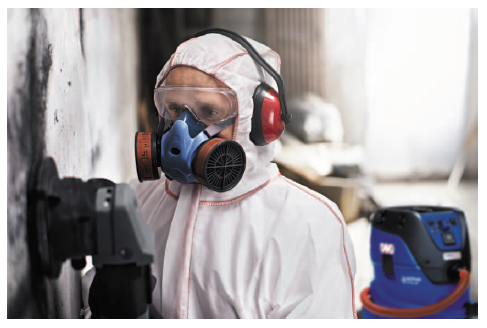Construction site dust and associated health risks to workers have been debated for some time, with previous guidelines no longer adequate enough to address dust levels and complexities on many modern construction sites.
Worksafe has now updated these guidelines, clarifying the level of dust extraction specification expected for workers working with Respirable Crystalline Silica (RCS) dust.
Silica is a substance found in concrete, bricks, rocks, stone, artificial or engineered composite stone benchtops, sand and clay.
RCS dust is created when materials containing silica are cut, ground, drilled, sanded, polished or disturbed.
Silicosis is a progressive and deadly disease that causes fibrosis of the lungs from the inhalation of RCS dust.
The Guidelines, Controlling Construction Dust with on-tool extraction, published in October 2019, provide very clear topics that need to be addressed by PCBUs in construction environments where dust is created by tools from drilling, grinding, cutting and sanding.
It also reinforces terms that many tradespeople may still not be familiar with, including:
• Local Exhaust Ventilation (LEV):
Using tools that provide Local Exhaust Ventilation (LEV) is recommended.
Often commonly thought of as a “dust port”, LEV is an attachment designed to channel the dust produced by each tool.
• Dust Extraction Unit:
When working with hazardous dust, tradespeople are encouraged to use a certified dust extractor that’s been tested, approved and designed to perform to a certified level.
Entry level vacuums, where the level of dust collection, filtration and leakage can’t be verified, is discouraged.
This is often the misconception about installing a High-Efficiency Particulate Air (HEPA) filter into non-certified vacuums — which is not an adequate safety solution.
HEPA is an inaccurate term in the field of dust extractors, and could mean as much as 15% of fine dust particles passing through the filter going straight back into the atmosphere, as well as dust leaking through inadequate seals and containment areas in these non-certified machines.
The required level depends on the hazardous nature of the dust being created, as identified by the building material’s manufacturer.
The International identification system of Low (L), Medium (M), or Hazardous/High (H) is used to identify the risk presented by the dust, and the solution provided by the dust extractor (see identification system at right).
This is defined by Australian/New Zealand Safety Standards.
Worksafe guidelines stipulate the use of a Certified H Class Dust Extractor solution when working with RCS dust.
• Interconnecting Hose Systems
Best practice dictates that tools that produce the dust, and the dust extractors that collect the dust, should interconnect with the correct hoses and fittings, even when the brands of tool/extractor differ.
These new guidelines encourage this best practice to become more prevalent on New Zealand construction sites.
• Maintenance and Training
Correct maintenance and operator training form important aspects of the PCBU’s responsibility to eliminate or reduce the level of construction site dust.
Operator training, regular maintenance and testing, as well as safe storage and transportation, are all elements that PCBUs need to have in place to ensure the chosen dust extraction equipment is being used correctly and effectively.
The dust risk identification system
L-Class Safety vacuums
MINIMUM 99% FILTRATION EFFICIENCY
Dust from dust class L may be picked up using these vacuum cleaners.
Application: Industry sectors such as woodworking, construction and manufacturing. If you are working with L Class hazardous dust select from this range.
M-Class Safety vacuums
MINIMUM 99.9% FILTRATION EFFICIENCY
Dusts from dust classes L and M may be picked up using these vacuum cleaners. These include all health-endangering, non-carcinogenic dusts with OEL-values > 0.1 mg/m3 and wood dusts.
Application: Industry sectors such as chemicals, wood, plastics, metal, pharmaceuticals, paper and textiles, for trades including carpenters, joiners and painters. If you are working with M Class hazardous dust select from this range.
H-Class Safety vacuums
MINIMUM 99.995% to 99.999% FILTRATION EFFICIENCY
Dusts from dust classes L, M and H, including asbestos, may be picked up using these vacuum cleaners. These include all health-endangering dusts with OEL-values, all carcinogenic dusts, and dusts contaminated with germs and bacteria.
Application: Industry and trade sectors as chemicals, plastics, pharmaceuticals, mining, paper and textiles, for trades such as roofers and painters. If you are working with H Class hazardous dust select from this range.
Ensure that operators of this equipment are suitably approved to undertake H Class-type work.
For more info, visit www.nilfisk.co.nz.




